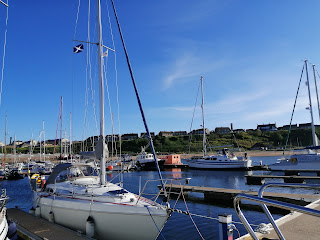Feeding the Rat
We are enjoying a rest day in Peterhead. The winds look more favourable tomorrow. Our gentle northward progress provides a suitable build up of anticipation for crossing the Pentland Firth and rounding Cape Wrath. Fishermen in Arbroath and Stonehaven, asking where we are heading, have shared their stories of incredible currents and intimidating waves. And they were going round in big steel boats with ten times the horsepower of our little engine. I have started to read the pilot carefully and fuss over the charts. I feel increasingly nervous. The fierce reputation of the Pentland Firth is undermining my confidence. Every now and then you might choose an adventure that is a bit more of a challenge, that is not just a fun weekend but actually might push you towards your limits or beyond. Mo Anthoine, an infamous British climber, referred to this as ‘feeding the rat’ which is defined in his biography of that name by Al Alvarez: ‘every year you need to flush out your system and do a bit of suffering, because there’s always a question of how you would perform’. For this mountaineer and would-be sailor, sailing round Cape Wrath via the Orkneys is feeding the rat. Lets just hope it does not turn out to be an epic.
In a lifetime of adventure, you might end up having an ‘epic’
which could stretch from a bit of suffering to a near death experience. Thirty
years ago, when visiting the Alps on a motorbike, Toni and I stopped off to
climb a route on the impressive 400 metre high Rocher D’Archiane in the Vercors
of southern France. We seriously underestimated the route and ended up having
an epic having set off late and carrying just a couple of crackers and a bottle
of water tied on a string round Toni’s waist. After just three or four pitches
we had to complete a pendulum. This is where you swing on a length of rope, in
this case it had been left in place by a previous party, to gradually work
sideways across a blank section of cliff to desperately clip a bolt on the far
side. Once you have crossed this pendulum pitch then the only way is up,
because below you is overhanging cliff, which in this case was not set up for
an abseil retreat. It was a long and boiling hot day on a south facing cliff
and we dropped the water bottle about halfway up. Despite, or perhaps because
of, our youthful arrogance we at least managed to climb the route competently.
Racing across the summit plateau we only just found the abseil chain before
darkness fell. Without head torches and after a couple of abseils into a rocky
chasm we slid down a pain-filled scree gully in our t-shorts and shorts to
reach the foot of the crag. I followed the base of the crag in the dark to
reach our small rucksack, which only contained two ‘Marks and Sparks’ lambs
wool jumpers and a first aid kit. Once we descended into the forest everything
became pitch black and we soon lost the footpath. Clambering down steep slopes
we could hear the river flowing down the rocky gorge below us, but it was all
getting out of control so Toni called a halt. We sat on the sloping forest floor
leaning back against two trees to wait for the dawn. It was a long night but
after a couple of hours I remembered that the first aid kit had some matches
and so in the coldest part of the night we managed to distract ourselves for an
hour or two by having a small twig fire on a rock between us. We drifted off to
sleep occasionally but our dreams were full of the water fountain in the tiny
village somewhere just a couple of kilometres away. At first light we staggered
down to find that fountain and quench our thirst. So Toni and I had a minor
overnight epic, which certainly was memorable. With hindsight we could easily
have carried the backpack with us, which would have avoided the dropped water
bottle and kept our backup gear, admittedly just the woolly jumpers, with us.
It was daft really not to carry a head torch and another bottle of water in
that backpack. Since that misadventure I have always carried a lightweight
emergency shelter. I have carried it on many adventures and never used it in
anger. To read about a proper ‘near-death’ climbing epic I would recommend
‘Fiva’ by Gordon Stainforth, which tells of two brothers spending three days on
a huge gnarly wall in Norway. After a three-day nightmare on an overhanging
cliff the moment that they arrive back at a road below offers a moment of
sweetness: ‘My feet drop down a short grassy bank onto horizontal tarmac. It
has all the satisfaction of scoring a bull’s eye at darts or winning the
football pools. What strange stuff this tarmac seems – but oh, oh, so lovely’.
I should be careful to touch wood writing this but, I do
seem to have avoided serious epics despite enjoying a lifetime of
mountaineering adventures. Perhaps I am simply cautious, maybe I choose
objectives that are well within my limits, possibly it is because I am willing
to turn back. My lack of epics is certainly not due to over-zealous advance
planning. However, I can assure you, I am doing some planning for this trip
round the top. Its all very well feeding the rat, but it seems important to live
to tell the tail.
Al Alvarez (1988) Feeding the Rat. London:
Bloomsbury.
Gordon Stainforth (2012) Fiva: an adventure that went
wrong. Golden Arrow: Brassington.




You're just the luckiest epic finder I know. Hope it is more fun than fear,you tiger
ReplyDeleteFrom Me!
ReplyDelete